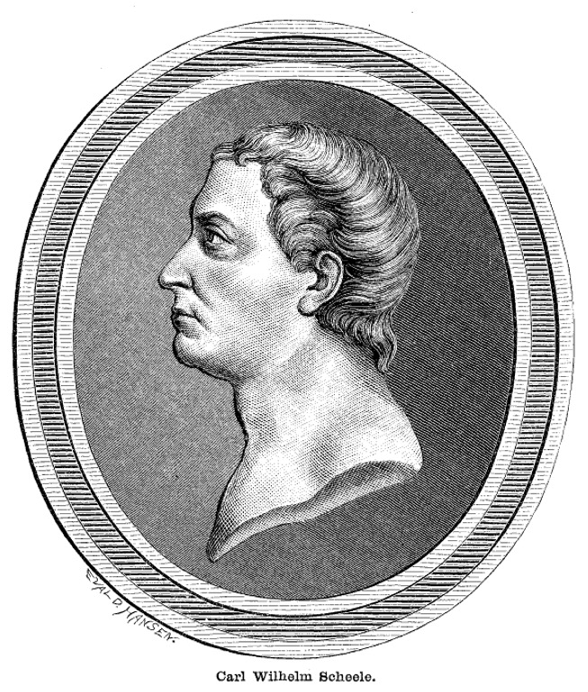
Carl Wilhelm Scheele (1742-1786)
On December 19, 1742 (Gregorian Calendar), Swedish Pomeranian pharmaceutical chemist Carl Wilhelm Scheele was born. Scheele is best known for his discovery of oxygen and other chemical elements.
Early Years
Carl Wilhelm Scheele was born in Stralsund, which was back then under the control of Sweden, but belongs to Germany on this day. During his childhood, friends of the family taught him reading prescriptions and equipped him with further chemical knowledge. At the age of 14, he apprenticed with a befriended pharmacist, where he was able to perform numerous experiments after his daily work. This period was very influential, and he stayed there for about eight years, while learning from the works of Nicolas Lemery, Caspar Neumann, and Georg Ernst Stahl.[4] Staring from 1765, Scheele worked for the apothecary C. M. Kjellström in Malmö and shortly after for A.J. Retzius, a professor at the University of Lund. When he began working as a pharmacist, Scheele discovered tartaric acid and researched on the relation of quicklime to calcium carbonate. Scheele got to know many influential scientists of this field and was able to slowly increase his reputation.
Turning towards Research
At Locke, Uppsala, Scheele became the director of the great pharmacy where he developed a great friendship with the chemistry professor Torbern Bergman. He was allowed to use Bergman’s laboratory and a fruitful working relationship between the scientists evolved. In 1777, Scheele got the chance to take part in a meeting of the Academy of Sciences and later on passed examination as apothecary before the Royal Medical College, with the highest honor. After that, Scheele devoted most of his time to research instead of his business.

Engraving on the title page of Scheele’s Chemical Treatise on Air and Fire (1777)
The Discovery of Oxygen
Starting during his teenage years, Scheele enjoyed to study air. Back then, the phlogiston theory was widely accepted. It described a fire-like element called phlogiston, contained within combustible bodies, that is released during combustion. It was first stated in 1667 by Johann Joachim Becher and when Scheele first learned about the theory of gases he also studied this now obsolete theory.[5] After discovering oxygen, Scheele named it ‘fire air’, because it supported combustion.
Still, he did not think this would disprove the phlogiston theory. But even though he never discarded the theory, historians and chemists on this day do not question Scheele’s role in the overturning of the theory. Unfortunately for Scheele, he did not recognize the significance of his discovery. However, during his correspondence with Lavoisier, the French chemist knew about this work’s importance very well.
More Elements to Discover
Next to oxygen, Scheele is credited with the discovery of chemical elements like barium, manganese, tungsten and several chemical compounds, such as citric acid, lactic acid, glycerol and more. Scheele also made up a process that is very similar to pasteurization and was a leading figure in Sweden becoming the world’s leading producers of matches.
In May 1786, Carl Wilhelm Scheele passed away and it was later found that he died of mercury poisoning. He was known to have been sniffing and tasting every new substance that he discovered and he was exposed to arsenic, mercury, lead and their compounds.
J. Michael McBride, Lecture 19 – Oxygen and the Chemical Revolution (Beginning to 1789) [7]
References and Further Reading:
- [1] Chemical Observations and Experiments on Air and Fire
- [2] Carl Wilhelm Scheele Website
- [3] Ferguson, John. “Karl Wilhelm Scheele”. Encyclopaedia Britannica. 1902.
- [4] Georg Ernst Stahl and the Phlogiston Theory, SciHi Blog
- [5] Johann Joachim Becher and the Phlogiston Theory of Combustion, SciHi Blog
- [6] Carl Scheele at Wikidata
- [7] J. Michael McBride, Lecture 19 – Oxygen and the Chemical Revolution (Beginning to 1789). CHEM 125a: Freshman Organic Chemistry I, Yale Courses @ youtube
- [8] Castle, Fred’k A.; Rice, Chas, eds. (1886). “Carl Wilhelm Scheele”. American Druggist. New York, U.S.A. 15 (August): 157–158
- [9] Works by or about Carl Wilhelm Scheele at Internet Archive
- [10] Carl Wilhelm Scheele’s d. Königl. Schwed. Acad. d. Wissenschaft Mitgliedes, Chemische Abhandlung von der Luft und dem Feuer in German
- [11] Timeline of chemists of the 18th century, via Wikidata






Pingback: Whewell’s Gazette: Year 03, Vol. #19 | Whewell's Ghost